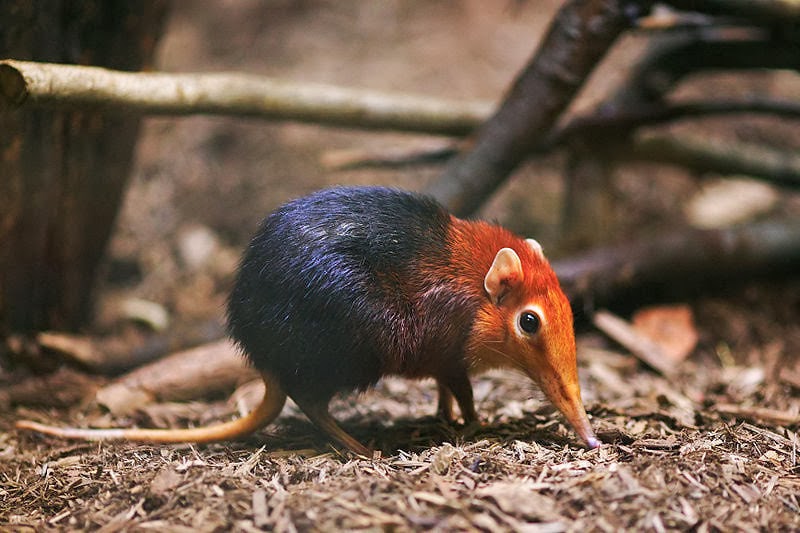The cutest of the "Little 5", the Elephant Shrew is a small, insect eating mammal with a long nose. Elephants Shrews are very common in Southern Africa but seldom seen. They can grow up to 30 cm and have relatively long legs which they use to hop about looking for food. Their little trunks are quite flexible and can be twisted to sniff out insects, which they then flick into their mouths using their tongues. They've been known to leap almost 3 feet in a single bound. Elephants Shrews are not very social and often live in monogamous pairs. They mark their territory with a strong scent produced by a gland under the tail. Scientists have recently discovered the Elephant Shrew may actually be more closely related to elephants than shrews.
The Buffalo Weaver bird can either refer to the common Black Buffalo Weaver, or White-headed Buffalo Weaver. Both are found in dry areas and are very common especially in East Africa. Out of all the Weavers, the Buffalo Weaver is a messy nest-maker. Their large communal nests have several side-entrances and are usually made of sticks and thorns. They are among the largest of the weaver birds, measuring up to 24 cm. Their diet consists of small and medium grass seed, small insects, and small fruits. They are quite loud and social these birds, with a range of cackles and calls.
We saw many of these flying around in Limpopo where they build their large nests in the huge baobab trees.
The Rhino Beetle is a large insect with ferocious looking body armor. They belong to the scarab beetle family (Scarabaeidae). Rhino Beetles can grow up to 2.5 inches long. Both sexes have similar body armor, but only the males have a large horn (hence the name "rhino") which they use in combat with other males. Rhino Beetles also use their horns to dig for food inside rotting tree trunks, or undergrowth. They actually have quite a varied diet, they'll eat rotting fruits, bark, sap and vegetable matter. Rhino Beetles are among the strongest living creatures in the world in proportion to their body weight. Rhino Beetle larvae can take up to five years to mature into an adult. They can be found throughout Africa.
Leopard Tortoises all have unique and beautiful
markings on their shells, hence their name. They can be found throughout
sub-Saharan Africa, mostly in the drier, grassy areas of the continent.
Leopard Tortoises generally eat grasses, and this must suit them well
because they live up to 100 years. They generally do not burrow except
when building a nest for their eggs. They are good diggers though. Leopard Tortoises can reach up to 18 inches in
length and weigh up to 40 lbs. They are solitary animals.
We saw one crossing the road when I volunteered in Kariega in the Eastern Cape. Azel, our volunteer leader, stopped the land cruiser and picked him up for us to see before safely putting him (or her ... we weren't quite sure!) on his destination side of the road.
The Antlion is the smallest member of the "Little 5" club, and in the US you may be more familiar with its name "doodlebug". The Antlion is the larvae stage of a winged insect that looks like a dragonfly. Antlions dig little conically shaped sand traps in the ground to catch small ants, which they eat by basically sucking them dry. They then toss out the dry carcass and wait for their next victim. Not surprising then, they tend to live in sandy, arid areas throughout Africa. The Antlion larvae has a wide body, large jaws and apparently lacks an anus. It is a bit of a mystery as to why they are called "Antlions", maybe because of their predatory nature.
We saw their sand traps on our walking safari in Mapungubwe. Our guide found one crawling around in the sand nearby and picked it up to show to us.
We saw one crossing the road when I volunteered in Kariega in the Eastern Cape. Azel, our volunteer leader, stopped the land cruiser and picked him up for us to see before safely putting him (or her ... we weren't quite sure!) on his destination side of the road.
The Antlion is the smallest member of the "Little 5" club, and in the US you may be more familiar with its name "doodlebug". The Antlion is the larvae stage of a winged insect that looks like a dragonfly. Antlions dig little conically shaped sand traps in the ground to catch small ants, which they eat by basically sucking them dry. They then toss out the dry carcass and wait for their next victim. Not surprising then, they tend to live in sandy, arid areas throughout Africa. The Antlion larvae has a wide body, large jaws and apparently lacks an anus. It is a bit of a mystery as to why they are called "Antlions", maybe because of their predatory nature.
We saw their sand traps on our walking safari in Mapungubwe. Our guide found one crawling around in the sand nearby and picked it up to show to us.






No comments:
Post a Comment